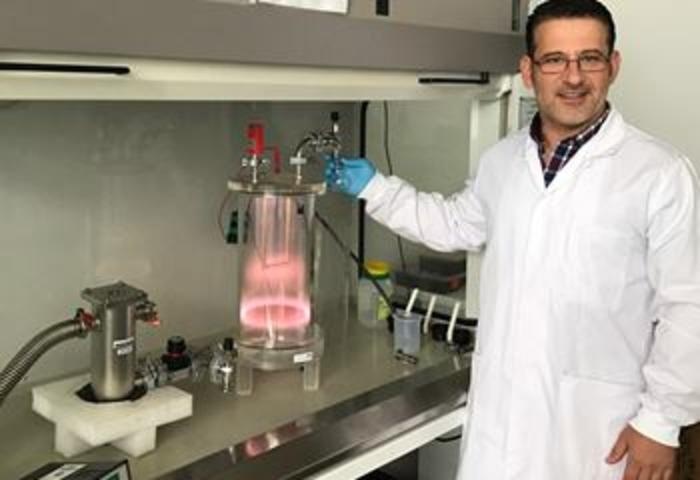A novel approach to send “friendly” nano-particles into the bloodstream of patients has shown optimistic results by changing the surface of potential vaccine, drug or cancer treatment delivery objects to provide the best result.
 Matthew Flinders Professor Krasimir Vasilev. Image Credit: Professor Krasimir Vasilev.
Matthew Flinders Professor Krasimir Vasilev. Image Credit: Professor Krasimir Vasilev.
Krasimir Vasilev, Professor of Biomedical Nanotechnology from Flinders University, is evaluating the body’s reactions to several surface treatments to nanoparticles in partnership with scientists from Australia and Germany’s Max Planck Institute for Polymer Research.
This unique method, known as “plasma polymer deposition,” demonstrates the ability to tune physiological responses to nanomaterials by modifying their surface chemical composition to fit a specific purpose.
Nanoparticles are frequently employed in biomedical applications — ranging from vaccines to drug delivery, therapeutics and diagnostics — typically triggering some sort of response from the body’s natural immune cells.
We are working on a wide range of nanoengineering techniques and technologies that are capable of tuning a body’s immune response to nanoparticles used in medical treatments and delivery of various therapeutics in order to improve their efficacy in advanced lifesaving applications.
Krasimir Vasilev, Matthew Flinders Professor, Flinders Health and Medical Research Institute, Flinders University
Professor Vasilev adds, “When a foreign object enters our body, naturally the body reacts to protect itself. That’s why we get scars from a cut, or an itch from a mosquito bite. Our immune system responds, even when the foreign object is much, much smaller than a splinter, in nano size. Yet there are fantastic things that can be achieved using very small particles. For instance, to deliver aggressive therapeutics to a cancer tumor without damaging the healthy organs around it.”
The surface properties of nano objects could be altered to influence how immune cells react to them. The study was published in the Nanomaterials journal.
Two chemistries generated significantly different responses: one produced an anti-inflammatory reaction, implying that the nano-carrier might bypass the body’s detection and circulate to its targeted destination. The other produced an inflammatory reaction, showing that this form of nanoparticle might boost the immune system and so could be useful as a vaccine.
The future of safer, more effective vaccines, drug delivery, and even cancer and other disease diagnostics and treatments could be closer with further investigations using this technique. This method can also be used to modify other objects, large or small, to suit a specific application—from the biomedical field to other purposes such as waterproofing, antimicrobial, high lubrication, and so on.
Melanie MacGregor, Study Co-Author and Associate Professor, Flinders University
Melanie MacGregor is also a Material Scientist and ARC Future Fellow who worked previously with Professor Vasilev at the Future Industries Institute at UniSA Mawson Lakes.
Journal Reference:
González-García, L. E., et al. (2022) Nanoparticles Surface Chemistry Influence on Protein Corona Composition and Inflammatory Responses. Nanomaterials. doi.org/10.3390/nano12040682.